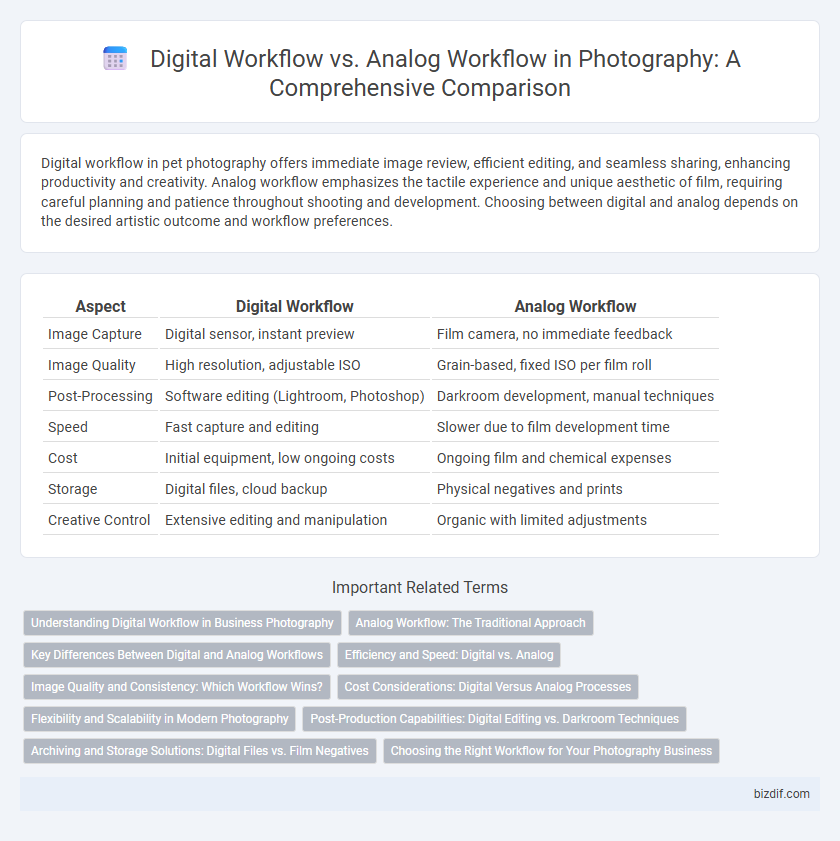Digital workflow in pet photography offers immediate image review, efficient editing, and seamless sharing, enhancing productivity and creativity. Analog workflow emphasizes the tactile experience and unique aesthetic of film, requiring careful planning and patience throughout shooting and development. Choosing between digital and analog depends on the desired artistic outcome and workflow preferences.
Table of Comparison
| Aspect | Digital Workflow | Analog Workflow |
|---|---|---|
| Image Capture | Digital sensor, instant preview | Film camera, no immediate feedback |
| Image Quality | High resolution, adjustable ISO | Grain-based, fixed ISO per film roll |
| Post-Processing | Software editing (Lightroom, Photoshop) | Darkroom development, manual techniques |
| Speed | Fast capture and editing | Slower due to film development time |
| Cost | Initial equipment, low ongoing costs | Ongoing film and chemical expenses |
| Storage | Digital files, cloud backup | Physical negatives and prints |
| Creative Control | Extensive editing and manipulation | Organic with limited adjustments |
Understanding Digital Workflow in Business Photography
Digital workflow in business photography streamlines image capture, editing, and distribution through software like Adobe Lightroom and Capture One, enhancing efficiency and consistency. Metadata embedding and non-destructive editing enable better organization and preservation of original files, supporting scalable project management. Cloud integration facilitates real-time collaboration and rapid client feedback, crucial for commercial photography timelines.
Analog Workflow: The Traditional Approach
Analog workflow in photography emphasizes manual processes such as film development, chemical processing, and darkroom printing, requiring hands-on expertise and tactile interaction with materials. This traditional approach offers unique image qualities like grain texture and tonal depth, which digital workflows often attempt to replicate but seldom match fully. Photographers favor analog methods for its artistic authenticity, deliberate pace, and the intimate connection it fosters between creator and medium.
Key Differences Between Digital and Analog Workflows
Digital workflows in photography offer instant image review, efficient file management, and seamless editing with software such as Adobe Lightroom and Photoshop, enabling rapid adjustments and high precision. Analog workflows rely on film development, chemical processing, and manual darkroom techniques, which require longer processing times and provide a tactile, hands-on experience with physical prints. Key differences include the speed of image acquisition, flexibility of post-processing, and the nature of storage--digital files versus physical negatives and prints.
Efficiency and Speed: Digital vs. Analog
Digital workflow enhances efficiency and speed by enabling instant image review, seamless editing, and rapid file sharing, reducing turnaround time significantly compared to analog processes. Analog workflow involves manual development, scanning, and physical printing, which are time-consuming and labor-intensive, limiting overall productivity. The immediacy of digital tools supports faster project completion and greater flexibility in post-processing than traditional analog methods.
Image Quality and Consistency: Which Workflow Wins?
Digital workflow delivers superior image quality through high-resolution sensors and advanced processing algorithms, ensuring consistent color accuracy and sharpness across shoots. Analog workflow, while prized for its unique tonal qualities and organic grain structure, often lacks the repeatability and precise control inherent in digital systems. Photographers seeking consistent results with minimal variability generally favor digital for its efficiency and reliable image fidelity.
Cost Considerations: Digital Versus Analog Processes
Digital photography significantly reduces ongoing costs through reusable storage and eliminating film purchase and development fees. Analog workflows incur continuous expenses for film rolls, chemical processing, and print materials, increasing overall expenditures per shoot. Investments in digital equipment may be higher initially, but the long-term savings and efficiency benefits often outweigh the recurring analog costs.
Flexibility and Scalability in Modern Photography
Digital workflow in modern photography offers unparalleled flexibility through instant image review, easy adjustments, and seamless integration with editing software, enabling photographers to adapt quickly to various shooting conditions. Scalability is enhanced by digital storage solutions and cloud-based platforms that support vast image libraries and collaborative projects without physical limitations. In contrast, analog workflow, while providing unique aesthetic qualities, lacks the immediate adaptability and effortless scalability necessary for today's fast-paced and high-volume photography demands.
Post-Production Capabilities: Digital Editing vs. Darkroom Techniques
Digital workflows offer extensive post-production capabilities with advanced software like Adobe Photoshop and Lightroom, enabling precise color correction, retouching, and layering that surpass analog methods. Analog workflows rely on traditional darkroom techniques such as dodging, burning, and chemical processing, which require specialized skills and offer limited control compared to digital editing tools. The flexibility and efficiency of digital post-production significantly enhance creative possibilities and streamline the editing process.
Archiving and Storage Solutions: Digital Files vs. Film Negatives
Digital workflows offer efficient archiving solutions through high-capacity cloud storage and metadata tagging, enabling rapid retrieval and long-term preservation of files. Film negatives require physical, climate-controlled storage environments to prevent degradation, with proper handling and indexing critical for maintaining accessibility. Digital files benefit from redundancy and easy duplication, while analog negatives rely on careful conservation to ensure archival longevity.
Choosing the Right Workflow for Your Photography Business
Selecting the right workflow for your photography business hinges on understanding the advantages of digital and analog processes. Digital workflows enable faster turnaround times, easier editing with software like Adobe Lightroom, and seamless integration with online platforms for client delivery. Analog workflows emphasize the artistic value of film grain, darkroom techniques, and tangible prints, attracting clients who appreciate craftsmanship and the tactile nature of traditional photography.
Digital workflow vs Analog workflow Infographic

 bizdif.com
bizdif.com